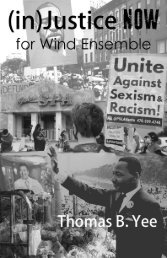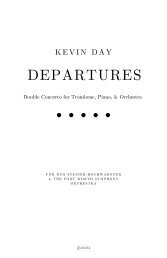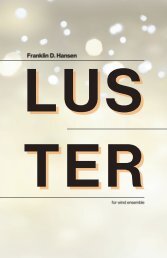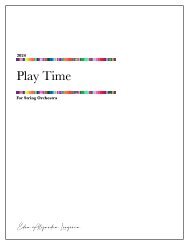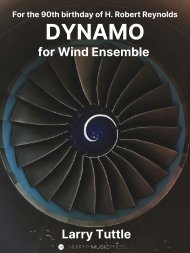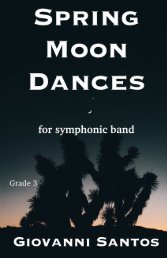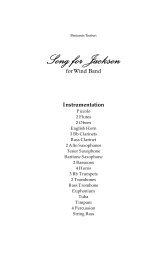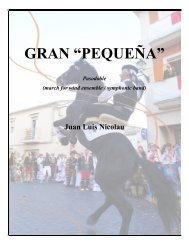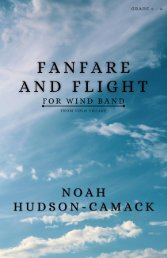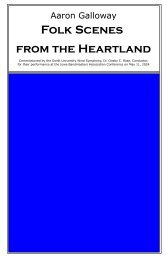Create successful ePaper yourself
Turn your PDF publications into a flip-book with our unique Google optimized e-Paper software.
SUGGESTED INSTRUMENTATION<br />
The following suggested instrumentation list is provided below, divided into the five parts each of these<br />
instruments has been assigned. Any combination of instruments at your discretion, as long as they each fulfill the<br />
five different parts, can be used to perform this work. Additional instrumental parts fulfilling another role are<br />
available upon request (ex: Bass Clarinet on Part IV instead of V).<br />
Experimentation with this piece's orchestration is highly recommeded. Use what available resources you have and<br />
get creative with color and texture (example: if you have an Electric Bass, or even an electric string quartet or<br />
quintet, use it! Go wild!). These experimentations can be used as a learning tool for your rehearsals and<br />
performances in how color and texture can change with even the smallest difference in orchestration (example:<br />
have the flutes play a melodic passage alone, then another high group of voices such as clarinet and/or soprano<br />
saxophone if available. What are the differences in timbre? Does it affect the mood or emotion of the piece? How,<br />
if so?). To that end, this version of the piece can be used as an endless sea of experimentation and creative<br />
possibilities for you and your students, no matter what the performance situation or instrumentation may be.<br />
PART I<br />
Piccolo 1<br />
Flute 1+2<br />
Oboe 1<br />
E-flat Clarinet<br />
B-flat Clarinet 1<br />
Soprano Saxophone<br />
B-flat Trumpet 1<br />
Violin 1 (optional)<br />
PART II<br />
Piccolo 2<br />
Flute 3+4<br />
Oboe 2<br />
B-flat Clarinet 2<br />
Alto Saxophone 1<br />
B-flat Trumpet 2<br />
Violin 2 (optional)<br />
PART III<br />
B-flat Clarinet 3<br />
Alto Saxophone 2<br />
Horn 1<br />
B-flat Trumpet 3<br />
Violin 3 (optional)<br />
Viola (optional)<br />
PART IV<br />
English Horn<br />
Bassoon 1<br />
Tenor Saxophone<br />
Horn 2<br />
Trombone 1<br />
Euphonium 1<br />
Violoncello (optional)<br />
PART V<br />
Bassoon 2<br />
Contrabassoon<br />
Bass Clarinet<br />
Contrabass Clarinet<br />
Baritone Saxophone<br />
Bass Saxophone<br />
Trombone 2<br />
Bass Trombone<br />
Euphonium 2<br />
Tuba<br />
Bass Guitar<br />
Double Bass (optional)<br />
ADDITIONAL INSTRUMENTS IF AVAILABLE<br />
Piano<br />
Keyboard Synthesizer<br />
PERCUSSION LIST<br />
All percussion is entirely optional. If parts can be assigned, preference should be given to drum set, auxiliary<br />
percussion, and timpani.<br />
Timpani, Glockenspiel, Marimba, Drum Set (snare, kick, 2 toms + floor tom, woodblock, hi-hat, crash), Bass Drum<br />
+ Suspended Cymbal (one player), Auxiliary Percussion (one player is preferred; use two players if available and<br />
absolutely necessary - Cowbell, Tambourine, Castanets, Maracas, Claves, Timbales)<br />
A Keyboard Synthesizer can also cover any of the mallet parts at your discretion - again, get creative and<br />
experiment as much as possible!<br />
BACKING TRACKS FOR THE PERCUSSION/ADDITIONAL INSTRUMENTS, AND CLICK TRACKS, ARE<br />
AVAILABLE UPON REQUEST. IT IS STRONGLY RECOMMENDED THAT YOU USE THEM FOR YOUR<br />
PERFORMANCE IF UNABLE TO ASSIGN THE PERCUSSION AND ADDITIONAL INSTRUMENTS.<br />
PERFORMANCE NOTES<br />
-References are given in the five parts for octave tranpositions (optional or otherwise) and solo passages (if any of<br />
the parts can be doubled). Additionally, a few passages have been omitted in individual instrumental parts if<br />
absolutely necessary (ex: if impossible for a specific instrument to play).<br />
-STRINGS (if used): If the parts are doubled, follow all guidelines, as written and at your discretion. If one player<br />
is used, the top line of every div. passage if preferred. Use double stops and triple stops wherever possible.<br />
Bowings should be determined by conductor and concertmaster before rehearsals and performance (ex: all slurred<br />
passages are phrase markings indicated to match the five parts exactly).




